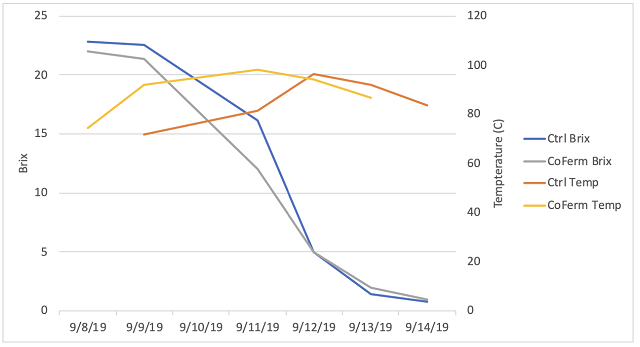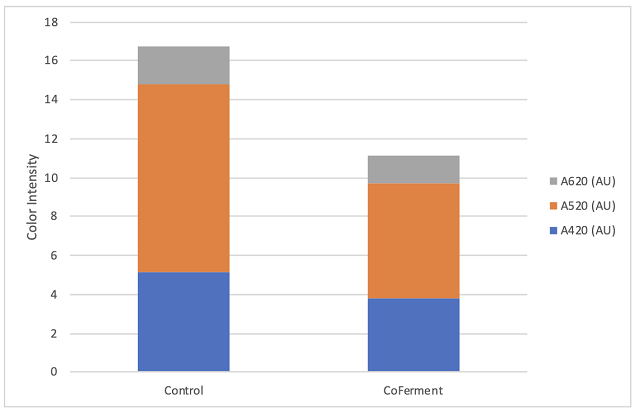Co-fermentation of Chambourcin with Viognier Pomace
Michael Heny
Michael Shaps Wineworks
Summary
The purpose of this experiment was to explore the chemical and sensory effects of the co-fermentation of Chambourcin with Viognier pomace. Final chemistry, phenolics and sensory properties were compared for two treatments: 100 % Chambourcin and 80% Chambourcin/20% Viognier skins. Addition of Viognier skins to Chambourcin fermentation had an immediate impact on the chemistry of the juice, lowering the TA and increasing the pH. The cofermentation bin produced the same yield as the bin with only Chambourcin, indicating a substantial increase in yield from Viognier skins. The co-fermented wine had much lower color intensity and total anthocyanins than the control wine, but higher concentrations of other phenolics including catechin (seed tannin) and total tannins. A panel of four winemakers tasting the wines blind noted that the co-fermented wine did not balance well, less like a red wine, more rustic, potentially with some reduction.
Introduction
The purpose of this experiment was to explore the chemical and sensory effects of the co-fermentation of Chambourcin with Viognier pomace. With thick skins and expressive flavors, Viognier has been an integral part of Virginia wine production since the early 1990’s. However, the same thick skins that make it more resistant to fungal pressure than some other Vinifera varieties also makes it more difficult to extract the juice from the berry. Producers typically see up to 50 liters per ton lower yield than with other white wine varieties. This study aims to find a synergistic use for Viognier pomace, an otherwise discarded raw material, with Chambourcin, the most widely planted red hybrid grape in the state1.
Winemakers use co-fermentation for many reasons. Some cite a “lifting of the aromas”, “enhanced texture”, “softening of the wine” or “improved brilliance and intensity of color”1,2. Previous published studies have found varying results when examining the effects of co-fermentation. One study found color enhancement when Sangiovese was co-fermented with Malvasia and Trebbiano while another found color was diluted in a co-fermentation of Syrah with Viognier5. Neither of these studies examined sensory aspects, however. In a previous WRE study in 2015, Emily Pelton from Veritas Vineyard and Winery found lower color when Cabernet Franc was co-fermented with 6% Viognier pomace. These wines were significantly different, with a preference for the control (100% Cabernet Franc) wine. In 2017, Milt and Sandy McPherson from Hunting Creek Vineyards co-fermented Petit Verdot with 10% Viognier pomace. In this trial, color was also lower in the co-fermented wines, but there were no sensory differences.
Several considerations led to the co-fermentation of Chambourcin with pressed Viognier skins:
- As an inter-specific hybrid, Chambourcin is expected to have lower tannin than Vitis vinifera species5, so unlike tannic varieties like Petit Verdot or Cabernet Franc, it is possible Chambourcin may gain phenolics from the addition of Viognier.
- Chambourcin sometimes has an off-putting acidity. Co-fermentation with skins from a high pH white grape variety may help temper the acidity of the Chambourcin.
- One of the Chambourcin-based red table blends produced at Michael Shaps Wineworks already includes Viognier as part of the blend. Co-fermentation may offer the opportunity to better integrate those flavors.
- Many East Coast wineries produce varietal Chambourcin wines. In a time when we are looking for ways to grow varieties that are tolerant to Virginia terroir (i.e. rain), Chambourcin shows promise. However, varietal Chambourcin wines can lack the complexity and phenolic structure desired in fine red wines. Identification of winemaking procedures to improve the sensory characters of Chambourcin could have a significant impact on acceptance and marketability of wine made from this grape variety. Co-fermentation with other varieties is one potential approach.
- In this study, final chemistry, phenolics and sensory properties were compared for two treatments: 100 % Chambourcin and 80% Chambourcin/20% Viognier skins.
Methods
Viognier was pressed the day before Chambourcin processing. Pomace was collected at the time of pressing, sparged with CO2 gas, covered with plastic wrap, and stored in a refrigerated room overnight until use in co-fermentation. Chambourcin was hand harvested and refrigerated overnight. The following day, macrobins were randomized for processing and destemmed into TBins. One bin received 1639 pounds of Chambourcin while the other received 1288 pounds of Charbourcin and 350 pounds of Viognier skins. Both bins were totaled 0.8 tons. All other additions and cellar operations were the same among bins. Each fermentation received 30 ppm SO2 and 0.1 mL/L Scottzyme Color Pro at destemming. Fermentations were inoculated with 0.25 g/L ICV GRE (Scottlabs) rehydrated in 0.15 g/L GoFerm. Fermentations were punched down twice per day and monitored daily for Brix and temperature. Superfood (0.6 g/L) and DAP (0.18 g/L) were added at 1/3 Brix depletion. Fermentations were pressed on the same day, at the completion of Brix depletion. Volume after pressing was recorded for yield calculation. Wine settled for 2 days prior to racking and transfer to comparable barrels. Malic acid depletion was monitored in barrel until completion and addition of 50 ppm SO2.
Due to restrictions put in place during the COVID-19 pandemic, group sensory analysis was not done on these wines. However, four winemakers tasted the wines blind and wrote open ended notes. A panel discussion was recorded; the full video can be found on the WRE YouTube channel.
Results/Discussion
The addition of Viognier skins to the Chambourcin fermentation had an immediate impact on the chemistry of the juice (Table 1), lowering the TA and increasing the pH considerably. This is likely due to an increase in the proportion of potassium coming from the skins of Viognier. Fermentation proceeded quickly at high temperature, with little difference in kinetics between the two lots (Figure 1). The pH difference seen in the juice persisted in the finished wine chemistry (Tables 2, 3), which also shows lower titratable acidity in the co-fermented wine. Differences in lactic acid between the two wines likely reflects differences in initial malic acid between Chambourcin and Viognier. The co-fermented wine had higher potassium, a result consistent with the addition of skins and the pH effect already observed.
Each bin received the same overall weight of grapes, and each treatment had the same yield after pressing (Table 4). This indicates that co-fermentation on pressed skins succeeded in extracting much more volume from the Viognier skins than pressing alone. It is surprising this volume was equal to that of fresh fruit, indicating this may be an economical way to utilize this otherwise wasted resource and augment volumes in Chambourcin.
The co-fermented wine had much lower color intensity and total anthocyanins than the control wine (Figure 2, Table 5). There is approximately 20% reduction in anthocyanins, indicating dilution in direct proportion to the addition of white grapes. The difference in color, however, is considerably larger. Color is affected by many factors, including pH. Anthocyanins are more likely to be found in their colored form at lower pH. The control wine has notably lower pH and much higher color expression.
With the exception of anthocyanins, co-fermentation of Chambourcin with Viognier appeared to increase other phenolics (Table 5); both catechin (seed tannin) and total tannins were higher in the co-fermented wine. There is little difference in phenolic content between red wine skins and white wine skins, with anthocyanins the sole exception. Instead, the difference is in the winemaking, with little skin contact time and limited extraction of phenolics in white wines vs. red wines6. In their study of co-fermentation of Viognier with Syrah, Casassa et al (2012) measured total skin and seed tannins in both varieties and found they were nearly the same4. Hybrid grapes, on the other hand, are known to contain lower levels of tannin (as much as five times less) as well as higher levels of protein that may remove tannin during fermentation5,7. In this case, addition of Vinifera to Chambourcin improved the proportion of extractable tannin available during fermentation, potentially leading to more structure in the finished wine.
Based on comments from four winemakers who tasted these wines blind, this Chambourcin was very concentrated with deep color, rich, ripe aromatics of raspberry and cranberry and noticeable acidity. The co-fermented wine was described as fruity with floral and sweet citrus aromas, black raspberry flavors and softer structure. Several winemakers noted that the co-fermented wine did not balance well, less like a red wine, more rustic, potentially with some reduction. One also noted bitterness, which may be a biproduct of added pomace contact.
Table 1: Primary juice chemistry for two treatments of Chambourcin (in-house data)

Figure 1: Fermentation kinetics for two treatments of Chambourcin (in-house data)

Table 2: Post-malolactic fermentation chemistry for two treatments of Chambourcin (in-house data)

Table 3: Wine chemistry for two treatments of Chambourcin (ICVLabs, March 2020)

Table 4: Yield for two treatments of Chambourcin (in-house data)

Figure 2: Color Intensity for two treatments of Chambourcin (ICVLabs, March 2020)

Table 5: Phenolic analysis for two treatments of Chambourcin (mg/L) (ETSLabs March 2020)

References
(1) Wood, V.; Custer, S.; Watson, K.; Alper, D. Virginia 2018 Commercial Grape Report. 11.
(2) Robinson, J. The Oxford Companion to Wine, 3rd Edition.; Oxford University Press: Oxford, 2006.
(3) Jackson, R. S. Wine Science: Principles and Applications, 4th Edition.; Academic Press: Amsterdam, 2014.
(4) Casassa, L. F.; Keirsey, L. S.; Mireles, M. S.; Harbertson, J. F. Cofermentation of Syrah with Viognier: Evolution of Color and Phenolics during Winemaking and Bottle Aging. Am J Enol Vitic. 2012, 63 (4), 538–543.
(5) Springer, L. F.; Sacks, G. Protein-Precipitable Tannin in Wines from Vitis Vinifera and Interspecific Hybrid Grapes (Vitis Sp.): Differences in Concentration, Extract- Ability, and Cell Wall Binding. Journal of Agricultural and Food Chemistry 62, 7515–7523.
(6) Price, S. F. Phenolic Analysis in White Wines and Juices at ETS Laboratories; Geneva, New York, 2006.
(7) Norton, E. L.; Sacks, G. L.; Talbert, J. N. Nonlinear Behavior of Protein and Tannin in Wine Produced by Cofermentation of an Interspecific Hybrid (Vitis Sp.) and Vinifera Cultivar. Am J Enol Vitic. 2020, 71 (1), 26–32.
